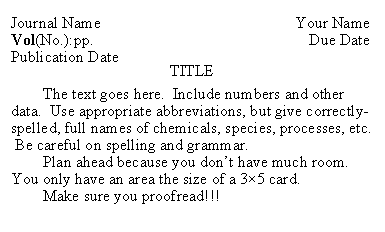
Guidlines and Instructions for Submitting Biology Newsnotes
If you already know what you’re doing, go here to
Submit, Read, and/or Comment on Newsnotes

NEWSNOTES are to be handed in on the days indicated. They are a biological current events activity, the concept of which was developed by Dr. David Fankhauser. For each newsnote that is due, you are asked to choose and summarize the one item from your reading, outside of the assigned class material, which you feel is the most significant and interesting to you. Articles could cover such topics as environmental issues, nutrition, medicine, disease prevention, or other areas of biological interest and can come from such sources as “reliable” newspapers (i. e., not those such as National Enquirer, etc.), magazines, scientific journals, books, etc. The most interesting newsnotes each due date will be photocopied and distributed for class discussion. The format for submission of your newsnote is as illustrated here. It should be typed in a space that is equivalent in area to one side only of a WHITE 3 × 5 card. While the preferred method to accomplish this is by submitting your newsnote via our Web site, turning in hard copy is also acceptable. However, other students will only be able to see and comment on your newsnote if you submit it online.
The basic point value received for turning in an acceptable newsnote is five (5) points. Those newsnotes which are selected for photocopying and in-class distribution (usually approximately ten newsnotes) will receive six (6) points, while seven (7) points will be given to the leading published newsnote each due date, according to the instructor’s subjective evaluation. One (1) point will be deducted, thus a total of only four (4) points awarded, if the newsnote is either a) handwritten rather than typed, b) of an improper size (too large or too small), c) not on white paper (can’t be photocopied), or d) if it does not deal with a biological topic. These points will be added to your cumulative score for the class. No late newsnotes will be accepted.
After each newsnote due-date, a number of the newsnotes will be photocopied and distributed in class as a focus for class discussion. You are also encouraged, both individually and within your study groups, to read (and discuss) all the newsnotes that have been submitted online. Pick several of the online newsnotes and/or newsnote comments to which you wish to respond. Think through, write, and submit your comment electronically, preferably within a week or so of the class discussion. As the idea here is to stimulate an online class “discussion,” feel free to comment on or reply to other people’s comments, but please remember that all comments posted must be polite and scholarly.
Five (5) points per comment, up to a total of 50 points (10 newsnote comments), will be added to your cumulative score for the course. However, to receive these points, the following conditions must be met:
Further note that, since whatever you write can and will be seen by anyone, anywhere in the world, it is not in your best interest to sign your name to a poorly-written newsnote or comment that contains numerous typographical errors, poor grammar, errors in capitalization, etc. Thus, typing up a newsnote or comment is not a last-minute, middle of the night-type thing, but rather you should plan ahead and PROOFREAD.
Notice that there is some additional information you will need in order to submit your newsnote: the publication date, the volume, and the number of the journal from which your article came. Of those three, the publication date may be the most obvious to most people. For a journal, a “volume” is a collection of a pre-determined group of “numbers.” Most journals consider a year’s-worth of “numbers” to be a “volume,” and for many journals, the volumes are numbered from the first year of publication. Thus, for example, for a journal that is published monthly and is in its fifth year of publication, the July issue might be “volume 5, number 7.” In typical biological citation format, the volume is indicated in bold typeface (underlined if typewritten or handwritten), while the (number) is indicated in parentheses. Those are followed by a colon, then the page number(s) of the particular article. Thus pages 2 through 3 in volume 5, number 7 would be indicated as “5(7):2-3.” Here are some examples from various popular-press publications. While volume and number are usually easy to find for a scientific journal, sometimes detective work is needed to find that information for popular-press publications.
 Let’s start with an “easy” example.
Here’s a sample from the cover of an issue of the American Automobile
Association’s magazine, Journeys:
Let’s start with an “easy” example.
Here’s a sample from the cover of an issue of the American Automobile
Association’s magazine, Journeys:
While their color contrast is a bit challenging, if you can see the print, it is evident that the publication date is 2009, but that doesn’t give any information about the volume or number. The next place to look is the table of contents in the front of the magazine. Here’s a bit of the top of that page:

From this, it is obvious that the
volume is 30 and the number is 5, so this would be written as
“30(5):__” where, just for this discussion, “__” indicates the
page numbers of the article you are citing. Thus, for example if
you wanted to cite the article on Indiana on pages 16 through 18, you would
use “30(5):16-18”.
Here’s another example, this time from Delicious Living magazine. Again, the first image is from the cover, and the second is from the table of contents.

 From this information, it’s obvious that the publication date is 2009, and
the volume and number would be listed as 25(9):__
From this information, it’s obvious that the publication date is 2009, and
the volume and number would be listed as 25(9):__
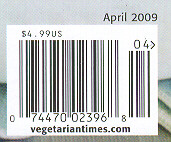
 Here’s a third, “easy” example
from Vegetarian Times magazine. Again, the first image is from the
cover, and the second from the table of contents.
Hopefully, you were able to spot
that the publication date is also 2009, while the volume and number are
35(5):__
Here’s a third, “easy” example
from Vegetarian Times magazine. Again, the first image is from the
cover, and the second from the table of contents.
Hopefully, you were able to spot
that the publication date is also 2009, while the volume and number are
35(5):__
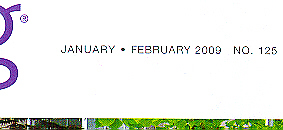
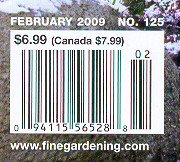 Here’s one from Fine Gardening magazine that’s harder to figure out.
The first image is from the table of contents, and the second is from the
cover.
From that, we can figure out that
the number is 125, but at first glance, that doesn’t seem to make sense. We
might expect that a newspaper that publishes daily editions might get up to
number 125 within a year, but this magazine doesn’t come out that often. The
next place to check for clues is the circulation information, which most
magazines put somewhere near the back. That says:
Here’s one from Fine Gardening magazine that’s harder to figure out.
The first image is from the table of contents, and the second is from the
cover.
From that, we can figure out that
the number is 125, but at first glance, that doesn’t seem to make sense. We
might expect that a newspaper that publishes daily editions might get up to
number 125 within a year, but this magazine doesn’t come out that often. The
next place to check for clues is the circulation information, which most
magazines put somewhere near the back. That says:

Note the text I’ve highlighted.
That gives us a bit more information. This magazine is only published 6 times
a year, so those 125 numbers are not all from the same year. At 6 issues per
year, that’s about 21 year’s-worth. Thus, I would conclude that they are not
making a distinction between different “volumes,” but rather, just tracking
all their “numbers” ever since the magazine began publication. So, just when
you thought you had the “rules” figured out, surprise! This one could
be cited as 1(125):__ [or possibly just (125):__ ].
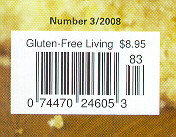

Here’s another example from
Gluten-Free Living that also takes a bit of “detective work.”
These first two images (cover and title page) are from an issue from 2008:
From that, we don’t know what the
volume is, but we know this issue is number 3 and its publication date was
2008. Let’s take a look at another issue from 2009:
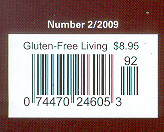

Hmmmm...., now what? There’s still
no clue as to the volume, but now it appears as though they went “backwards”
to number 2. Let’s check the circulation information on this one, too.
 Here’s a clue (highlighted
in yellow). They say the magazine is published quarterly, so there would be
4 “numbers” per year. Putting all the information together, it would appear
that they’re using the year as a volume number. Thus, 2008(3):__, the
third one published in 2008, would, indeed, come before 2009(2):__,
the second one published in 2009.
Here’s a clue (highlighted
in yellow). They say the magazine is published quarterly, so there would be
4 “numbers” per year. Putting all the information together, it would appear
that they’re using the year as a volume number. Thus, 2008(3):__, the
third one published in 2008, would, indeed, come before 2009(2):__,
the second one published in 2009.
Thus, when you put it all together, you might end up with something like:
| National Geographic | John Doe |
| 215(5):30-51 | Due: 9/23/2009 |
| May 2009 | Submitted: 4-Jul-2009 |
| Ice Baby | |
| This article was about a nearly-perfect wooly mammoth calf who, 40,000 years ago, slipped into a river, inhaling mud that asphyxiated her. Preserved in the icy water and subsequent frozen tundra, her body resurfaced, again in May of 2007. Scientists performed a CT scan, then obtained and analyzed tissue samples to study her body. By analyzing her teeth, the researchers were able to determine that she was born in late spring, that she was healthy and well-fed, and that she was only about a month old when she died. | |
Submit, Read, and/or Comment on Newsnotes